Evolution Wave Condition Using WAVEWATCH III for Island Sheltered Area in the South China Sea
Abstract
1. Introduction
2. Methods and Data
2.1. Study Area
2.2. Spectral Balancing Equation
2.3. Spatial Grids
2.4. Wave Model Setup
- Zieger et al. 2015 (ST6) package [19].
2.5. Wind Field Data
2.6. Sea Condition
3. Results and Discussions
3.1. Moderate Sea State Wave Hindcasts
3.1.1. Significant Wave Height (SWH)
3.1.2. Mean Wave Period Validation
3.2. Typhoon Sea State Wave Hindcasts
3.2.1. Significant Wave Height (SWH)
3.2.2. Mean Wave Period Validation
3.2.3. Wave Spectrum
3.2.4. Spatial Distribution of Significant Wave Heights
4. Summary and Conclusions
Author Contributions
Funding
Institutional Review Board Statement
Informed Consent Statement
Data Availability Statement
Conflicts of Interest
References
- Zhou, L.; Li, Z.; Mou, L.; Wang, A. Numerical simulation of wave field in the South China Sea using WAVEWATCH III. Chin. J. Oceanol. Limnol. 2014, 32, 656–664. [Google Scholar] [CrossRef]
- Aymeric, J.; Lefebvre, J.P.; Douillet, P.; Ouillon, S.; Schmied, L. Wind wave measurements and modelling in a fetch-limited semi-enclosed lagoon. Coast. Eng. 2008, 56, 599–608. [Google Scholar]
- Mediavilla, D.G.; Sepúlveda, H.H. Nearshore assessment of wave energy resources in central Chile (2009–2010). Renew. Energy 2016, 90, 136–144. [Google Scholar] [CrossRef]
- Ali, A.; Roland, A.; Van Der Westhuysen, A.; Meixner, J.; Chawla, A.; Hesser, T.J.; Smith, J.M.; Sikiric, M.D. Large-scale hurricane modeling using domain decomposition parallelization and implicit scheme implemented in WAVEWATCH III wave model. Coast. Eng. 2020, 157, 103656. [Google Scholar]
- Aror, R.D.; Patty, W.; Ramdhani, A. Utilization of Wavewatch III Model Output Data for High Wave Analysis. ILMU KELAUTAN Indones. J. Mar. Sci. 2019, 24, 132–138. [Google Scholar] [CrossRef]
- Jiang, L.F.; Zhang, Z.X.; Qi, Y.Q. Simulations of SWAN and WAVEWATCH III in northern south China sea. In Proceedings of the Twentieth International Offshore and Polar Engineering Conference, Beijing, China, 20–25 June 2010; OnePetro: Richardson, TX, USA, 2010. [Google Scholar]
- Hanson, J.L.; Tracy, B.A.; Tolman, H.L.; Scott, R.D. Pacific hindcast performance of three numerical wave models. J. Atmos. Ocean. Technol. 2009, 26, 1614–1633. [Google Scholar] [CrossRef]
- Ortiz-Royero, J.C.; Mercado-Irizarry, A. An intercomparison of SWAN and WAVEWATCH III models with data from NDBC-NOAA buoys at oceanic scales. Coast. Eng. J. 2008, 50, 47–73. [Google Scholar] [CrossRef]
- Padilla-Hernandez, R.; Perrie, W.; Toulany, B.; Smith, P.C.; Zhang, W.; Jimenez-Hernandez, S. Intercomparison of modern operational wave models. In Proceedings of the 8th International Workshop on Wave Hindcasting and Forecasting, Oahu, HI, USA, 14–19 November 2004. [Google Scholar]
- Qingxiang, L.; Rogers, W.E.; Babanin, A.V.; Young, I.R.; Romero, L.; Zieger, S.; Qiao, F.; Guan, C. Observation-Based Source Terms in the Third-Generation Wave Model WAVEWATCH III: Updates and Verification. J. Phys. Oceanogr. 2019, 49, 489–517. [Google Scholar]
- Wei, Z.; Guan, S.; Hong, X.; Li, P.; Tian, J. Examination of wind-wave interaction source term in WAVEWATCH III with tropical cyclone wind forcing. Acta Oceanol. Sin. 2011, 30, 1–13. [Google Scholar]
- Amrutha, M.M.; Kumar, V.S.; Sandhya, K.G.; Nair, T.B.; Rathod, J.L. Wave hindcast studies using SWAN nested in WAVEWATCH III—Comparison with measured nearshore buoy data off Karwar, eastern Arabian Sea. Ocean. Eng. 2016, 119, 114–124. [Google Scholar] [CrossRef]
- Komen, G.J.; Hasselmann, K. On the existence of a fully developed wind-sea spectrum. J. Phys. Oceanogr. 1984, 14, 1271–1285. [Google Scholar] [CrossRef]
- Snyder, R.L.; Dobson, F.W.; Elliott, J.A.; Long, R.B. Array measurements of atmospheric pressure fluctuations above surface gravity waves. J. Fluid Mech. 1981, 102, 1–59. [Google Scholar] [CrossRef]
- Tolman, H.L.; Chalikov, D. Source terms in a third-generation wind wave model. J. Phys. Oceanogr. 1996, 26, 2497–2518. [Google Scholar] [CrossRef]
- Bidlot, J.; Janssen, P.; Abdalla, S.; Hersbach, H. A Revised Formulation of Ocean Wave Dissipation and Its Model Impact; European Centre for Medium-Range Weather Forecasts: Reading, UK, 2007. [Google Scholar]
- Janssen, P.A. Quasi-linear theory of wind-wave generation applied to wave forecasting. J. Phys. Oceanogr. 1991, 21, 1631–1642. [Google Scholar] [CrossRef]
- Ardhuin, F.; Rogers, E.; Babanin, A.V.; Filipot, J.-F.; Magne, R.; Roland, A.; Van Der Westhuysen, A.; Queffeulou, P.; Lefevre, J.-M.; Aouf, L.; et al. Semiempirical Dissipation Source Functions for Ocean Waves. Part I: Definition, Calibration, and Validation. J. Phys. Oceanogr. 2010, 40, 1917–1941. [Google Scholar] [CrossRef]
- Zieger, S.; Babanin, A.V.; Erick Rogers, W.; Young, I.R. Observation-based source terms in the third-generation wave model WAVEWATCH. Ocean. Model. 2015, 96, 2–25. [Google Scholar] [CrossRef]
- Liu, Q.; Babanin, A.; Fan, Y.; Zieger, S.; Guan, C.; Moon, I.J. Numerical simulations of ocean surface waves under hurricane conditions: Assessment of existing model performance. Ocean. Model. 2017, 118, 73–93. [Google Scholar] [CrossRef]
- Kalourazi, M.Y.; Siadatmousavi, S.M.; Yeganeh-Bakhtiary, A.; Jose, F. WAVEWATCH-III source terms evaluation for optimizing hurricane wave modeling: A case study of Hurricane Ivan. Oceanologia 2021, 63, 194–213. [Google Scholar] [CrossRef]
- Mentaschi, L.; Besio, G.; Cassola, F.; Mazzino, A. Performance evaluation of Wavewatch III in the Mediterranean Sea. Ocean. Model. 2015, 90, 82–94. [Google Scholar] [CrossRef]
- Kalantzi, G.D.; Gommenginger, C.; Srokosz, M. Assessing the Performance of the Dissipation Parameterizations in WAVEWATCH III Using Collocated Altimetry Data. J. Phys. Oceanogr. 2009, 39, 2800–2819. [Google Scholar] [CrossRef]
- Foli, B.A.K.; Ansong, J.K.; Addo, K.A.; Wiafe, G. A WAVEWATCH III® Model Approach to Investigating Ocean Wave Source Terms for West Africa: Input-Dissipation Source Terms. Remote Sens. Earth Syst. Sci. 2022, 5, 95–117. [Google Scholar] [CrossRef]
- Umesh, P.A.; Behera, M.R. Performance evaluation of input-dissipation parameterizations in WAVEWATCH III and comparison of wave hindcast with nested WAVEWATCH III-SWAN in the Indian Seas. Ocean. Eng. 2020, 202, 106959. [Google Scholar] [CrossRef]
- Sheng, Y.; Shao, W.; Li, S.; Zhang, Y.; Yang, H.; Zuo, J. Evaluation of Typhoon Waves Simulated by WaveWatch-III Model in Shallow Waters Around Zhoushan Islands. J. Ocean. Univ. China 2019, 18, 365–375. [Google Scholar] [CrossRef]
- Wang, J.; Zhang, J.; Yang, J.; Bao, W.; Wu, G.; Ren, Q. An evaluation of input/dissipation terms in WAVEWATCH III using in situ and satellite significant wave height data in the South China Sea. Acta Oceanol. Sin. 2017, 36, 20–25. [Google Scholar] [CrossRef]
- Seemanth, M.; Bhowmick, S.A.; Kumar, R.; Sharma, R. Sensitivity analysis of dissipation parameterizations in a third-generation spectral wave model, WAVEWATCH III for Indian Ocean. Ocean. Eng. 2016, 124, 252–273. [Google Scholar] [CrossRef]
- Montoya, R.D.; Osorio Arias, A.; Ortiz Royero, J.C.; Ocampo-Torres, F.J. A wave parameters and directional spectrum analysis for extreme winds. Ocean. Eng. 2013, 67, 100–118. [Google Scholar] [CrossRef]
- Sun, Z.; Zhang, H.; Liu, X.; Ding, J.; Xu, D.; Cai, Z. Wave energy assessment of the Xisha Group Islands zone for the period 2010–2019. Energy 2021, 220, 119721. [Google Scholar] [CrossRef]
- Tolman, H.L. Treatment of unresolved islands and ice in wind wave models. Ocean. Model. 2003, 5, 219–231. [Google Scholar] [CrossRef]
- Sun, Z.; Zhang, H.; Xu, D.; Liu, X.; Ding, J. Assessment of wave power in the South China Sea based on 26-year high-resolution hindcast data. Energy 2020, 197, 117218. [Google Scholar] [CrossRef]
- Bi, F.; Song, J.; Wu, K.; Xu, Y. Evaluation of the simulation capability of the Wavewatch III model for Pacific Ocean wave. Acta Oceanol. Sin. 2015, 34, 43–57. [Google Scholar] [CrossRef]
- Lee, H.S. Evaluation of WAVEWATCH III performance with wind input and dissipation source terms using wave buoy measurements for October 2006 along the east Korean coast in the East Sea. Ocean. Eng. 2015, 100, 67–82. [Google Scholar] [CrossRef]
- WID Group. User Manual and System Documentation of WAVEWATCH III Version 5.16; NOAA/NWS/NCEP/MMAB Technical Note 329; WID Group: Bernay, France, 2016; pp. 1–326. [Google Scholar]
- The Wamdi Group. The WAM model—A third generation ocean wave prediction model. J. Phys. Oceanogr. 1988, 18, 1775–1810. [Google Scholar] [CrossRef]
- Longuet-Higgins, M.S.; Stewart, R.W. Radiation stress and mass transport in gravity waves, with application to ‘surf beats’. J. Fluid Mech. 1962, 13, 481–504. [Google Scholar] [CrossRef]
- Longuet-Higgins, M.S.; Stewart, R.W. The changes in amplitude of short gravity waves on steady non-uniform currents. J. Fluid Mech. 1961, 10, 529–549. [Google Scholar] [CrossRef]
- Tolman, H.L.; Balasubramaniyan, B.; Burroughs, L.D.; Chalikov, D.V.; Chao, Y.Y.; Chen, H.S.; Gerald, V.M. Development and Implementation of Wind-Generated Ocean Surface Wave Modelsat NCEP. Weather. Forecast. 2002, 17, 311–333. [Google Scholar] [CrossRef]
- Roland, A. Development of WWM II: Spectral Wave Modelling on Unstructured Meshes. Ph.D. Thesis, Technische Universität Darmstadt, Institute of Hydraulic and Water Resources Engineering, Darmstadt, Germany, 2008. [Google Scholar]
- Tolman, H.L. User Manual and System Documentation of WAVEWATCH III TM Version 3.14; Technical Note, MMAB Contribution; U. S. Department of Commerce National Oceanic and Atmospheric Administration National Weather Service: Camp Springs, MD, USA, 2009; Volume 276.
- Tolman, H.L. Alleviating the garden sprinkler effect in wind wave models. Ocean. Model. 2002, 4, 269–289. [Google Scholar] [CrossRef]
- Chalikov, D. The parameterization of the wave boundary layer. J. Phys. Oceanogr. 1995, 25, 1333–1349. [Google Scholar] [CrossRef]
- Chalikov, D.V.; Belevich, M.Y. One-dimensional theory of the wave boundary layer. Bound. Layer Meteorol. 1993, 63, 65–96. [Google Scholar] [CrossRef]
- Bidlot, J. Present Status of Wave Forecasting at ECMWF; Workshop on Ocean Waves: South Bend, IN, USA, 2012; pp. 25–27. [Google Scholar]
- Tolman, H.L. Effects of numerics on the physics in a third-generation wind-wave model. J. Phys. Oceanogr. 1992, 22, 1095–1111. [Google Scholar] [CrossRef]
- Hasselmann, S.; Hasselmann, K.; Allender, J.H.; Barnett, T.P. Computations and parameterizations of the nonlinear energy transfer in a gravity-wave specturm. Part II: Parameterizations of the nonlinear energy transfer for application in wave models. J. Phys. Oceanogr. 1985, 15, 1378–1391. [Google Scholar] [CrossRef]
- Tolman, H.L. A third-generation model for wind waves on slowly varying, unsteady, and inhomogeneous depths and currents. J. Phys. Oceanogr. 1991, 21, 782–797. [Google Scholar] [CrossRef]
- Hasselmann, K.; Barnett, T.P.; Bouws, E.; Carlson, H.; Cartwright, D.E.; Enke, K.; Ewing, J.A.; Gienapp, A.; Hasselmann, D.E.; Kruseman, P.; et al. Measurements of wind-wave growth and swell decay during the Joint North Sea Wave Project (JONSWAP). Ergaenzungsheft Dtsch. Hydrogr. Z. Reihe A 1973. [Google Scholar]
- Battjes, J.A.; Janssen, J. Energy loss and set-up due to breaking of random waves. In Proceedings of the 16th International Conference on Coastal Engineering, Coastal Engineering Proceedings, Hamburg, Germany, 27 August–3 September 1978; p. 32. [Google Scholar]
- Desbiolles, F.; Blanke, B.; Bentamy, A. Short-term upwelling events at the western African coast related to synoptic atmospheric structures as derived from satellite observations. J. Geophys. Res. Ocean. 2014, 119, 461–483. [Google Scholar] [CrossRef]
- Mulligan, R.P.; Bowen, A.J.; Hay, A.E.; Van Der Westhuysen, A.J.; Battjes, J.A. Whitecapping and wave field evolution in a coastal bay. J. Geophys. Res. 2008, 113. [Google Scholar] [CrossRef]
- Holthuijsen, L.H.; Booij, N.; Bertotti, L. The Propagation of Wind Errors Through Ocean Wave Hindcasts. J. Offshore Mech. Arct. Eng. 1996, 118, 184–189. [Google Scholar] [CrossRef]
- Li, B.; Chen, W.; Li, J.; Liu, J.; Shi, P.; Xing, H. Wave energy assessment based on reanalysis data calibrated by buoy observations in the southern South China Sea. Energy Rep. 2022, 8, 5067–5079. [Google Scholar] [CrossRef]
- Shi, H.; Cao, X.; Li, Q.; Li, D.; Sun, J.; You, Z.; Sun, Q. Evaluating the Accuracy of ERA5 Wave Reanalysis in the Water Around China. J. Ocean. Univ. China 2021, 20, 1–9. [Google Scholar] [CrossRef]
- Zhang, H.; He, H.; Zhang, W.-Z.; Di Tian, D. Upper ocean response to tropical cyclones: A review. Geosci. Lett. 2021, 8, 1. [Google Scholar] [CrossRef]
- Chen, C. Case study on wave-current interaction and its effects on ship navigation. J. Hydrodyn. 2018, 30, 411–419. [Google Scholar] [CrossRef]
- Holthuijsen, L.H. Waves in Oceanic and Coastal Waters; Cambridge University Press: Cambridge, UK, 2010. [Google Scholar]
- Mahmoudof, S.M.; Badiei, P.; Siadatmousavi, S.M.; Chegini, V. Spectral Wave Modeling in Very Shallow Water at Southern Coast of Caspian Sea. J. Mar. Sci. Appl. 2018, 17, 140–151. [Google Scholar] [CrossRef]
- Dora, G.U.; Kumar, V.S. Sea state observation in island-sheltered nearshore zone based on in situ intermediate-water wave measurements and NCEP/CFSR wind data. Ocean. Dyn. 2015, 65, 647–663. [Google Scholar] [CrossRef]
- Chen, Y.H.; Wang, H. Numerical model for nonstationary shallow water wave spectral transformations. J. Geophys. Res. Oceans 1983, 88, 9851–9863. [Google Scholar] [CrossRef]
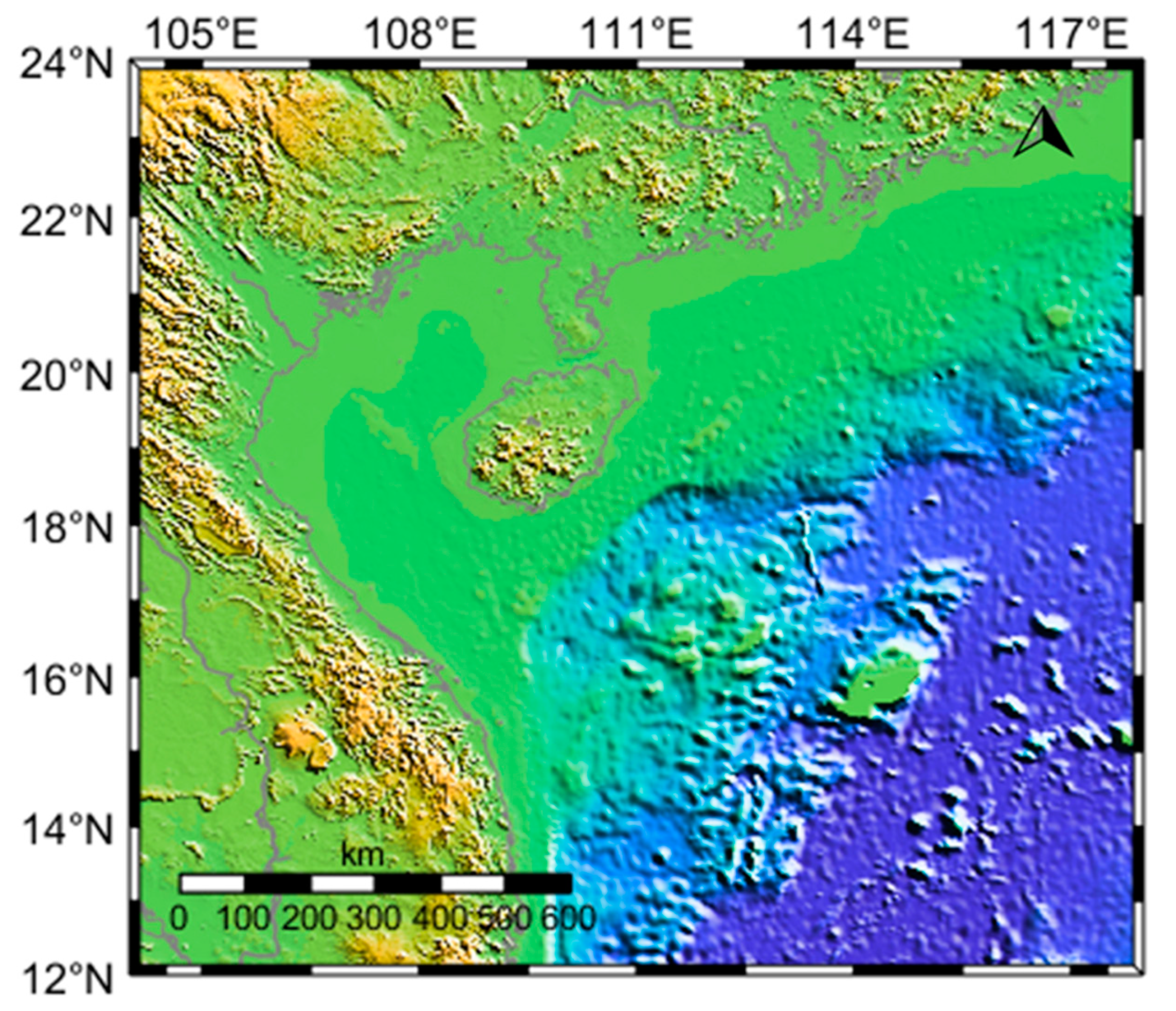

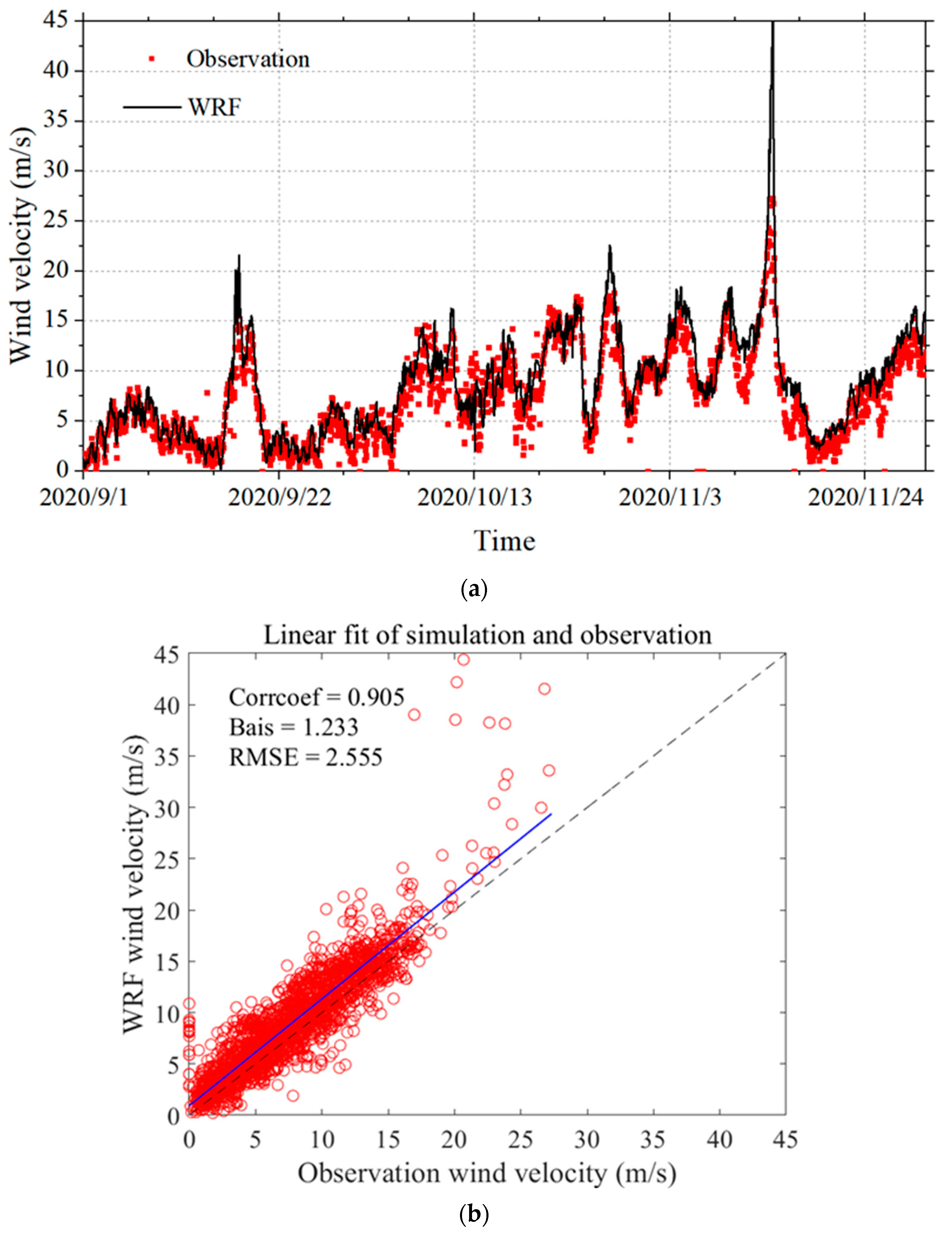
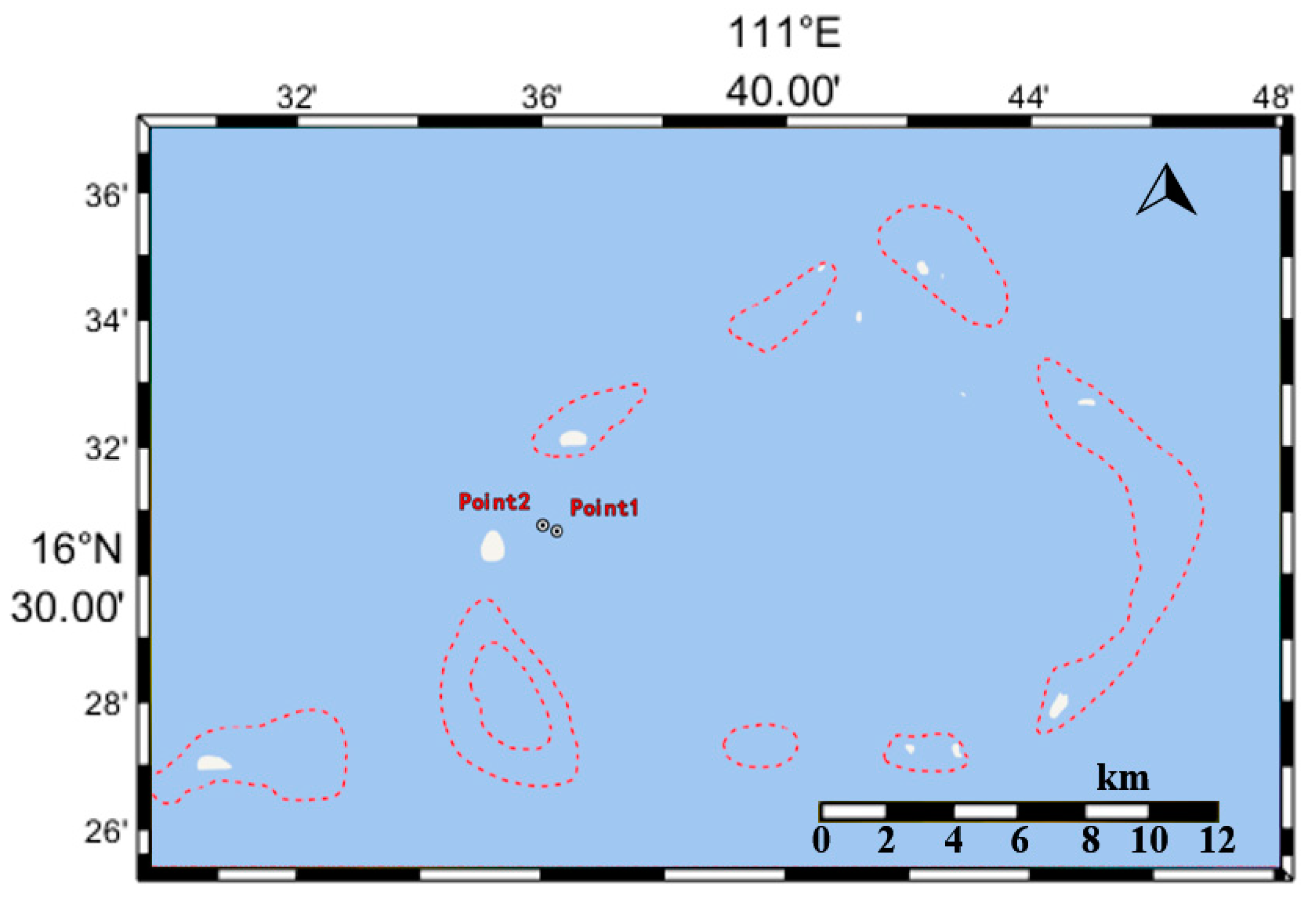
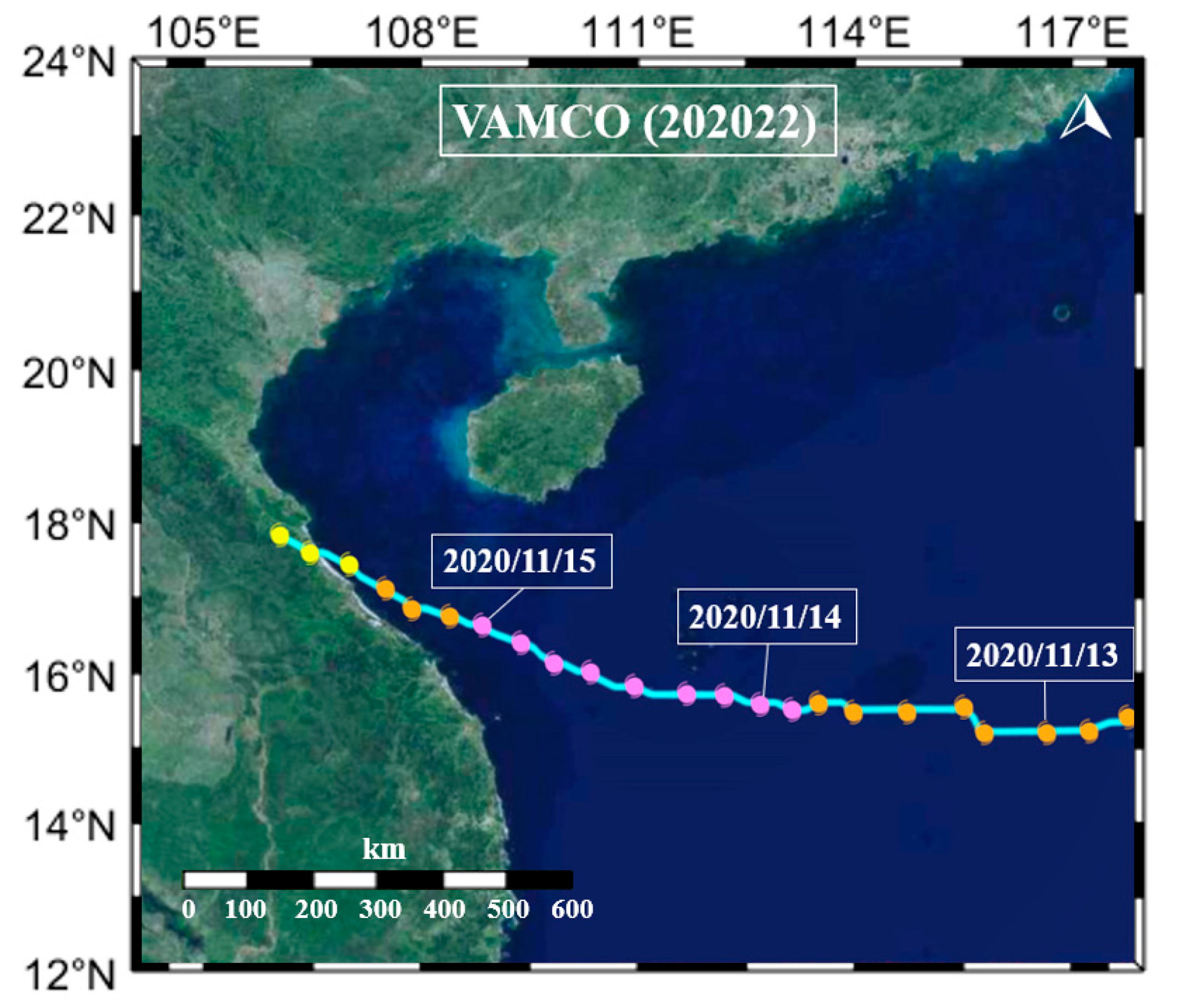
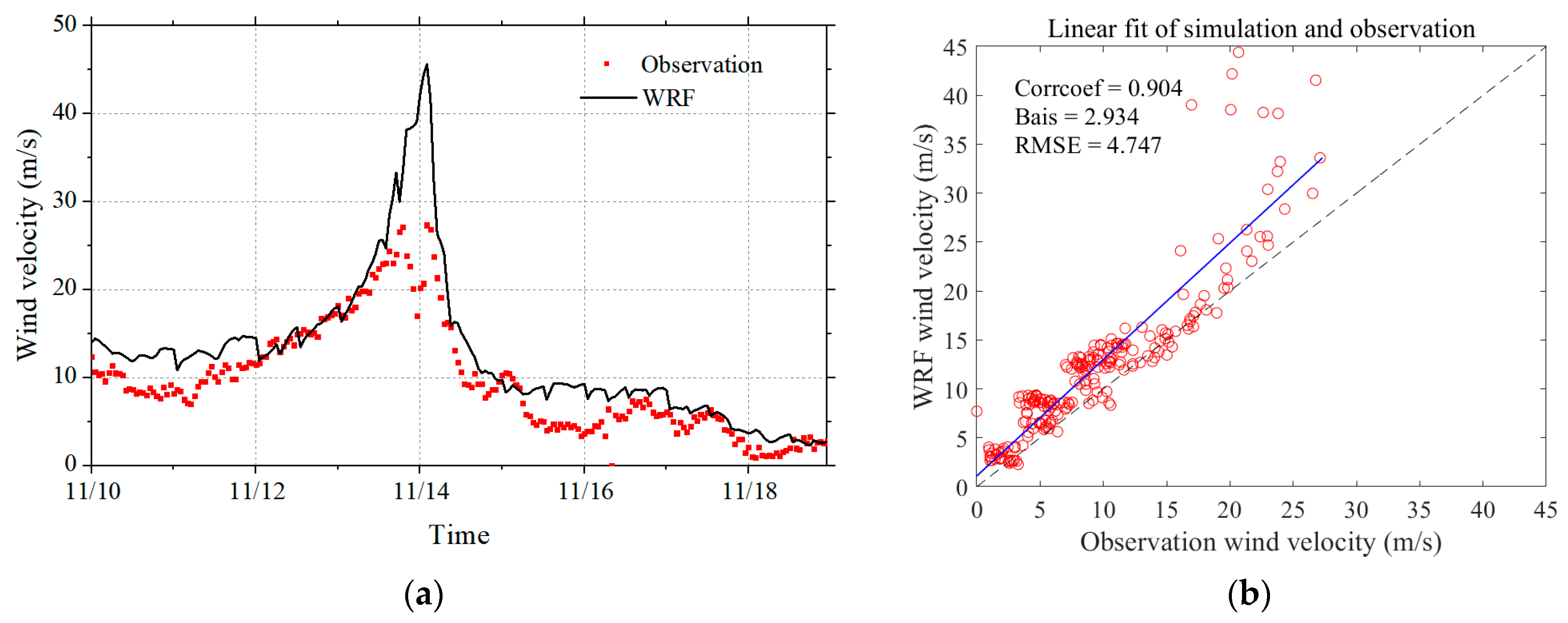
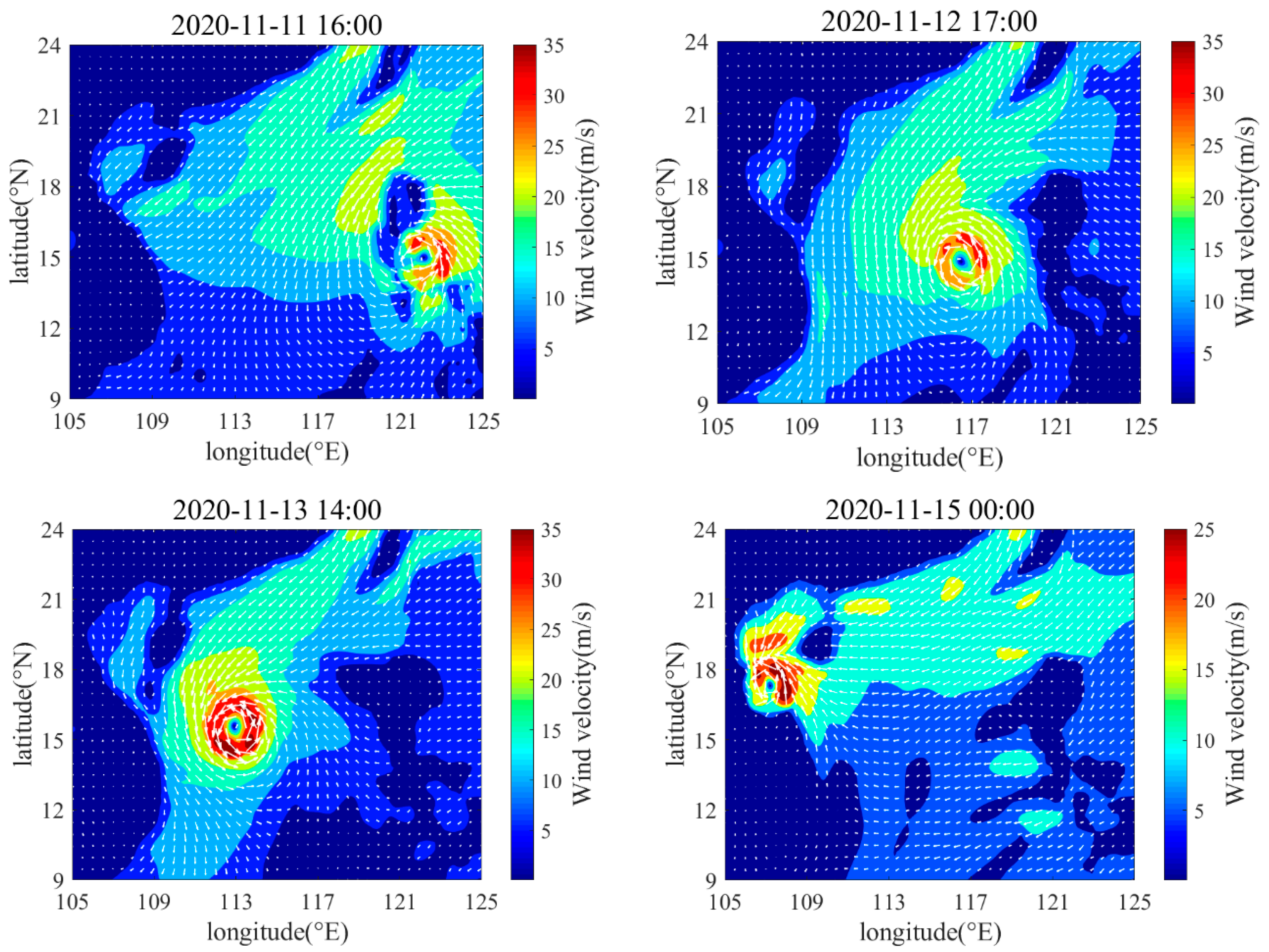

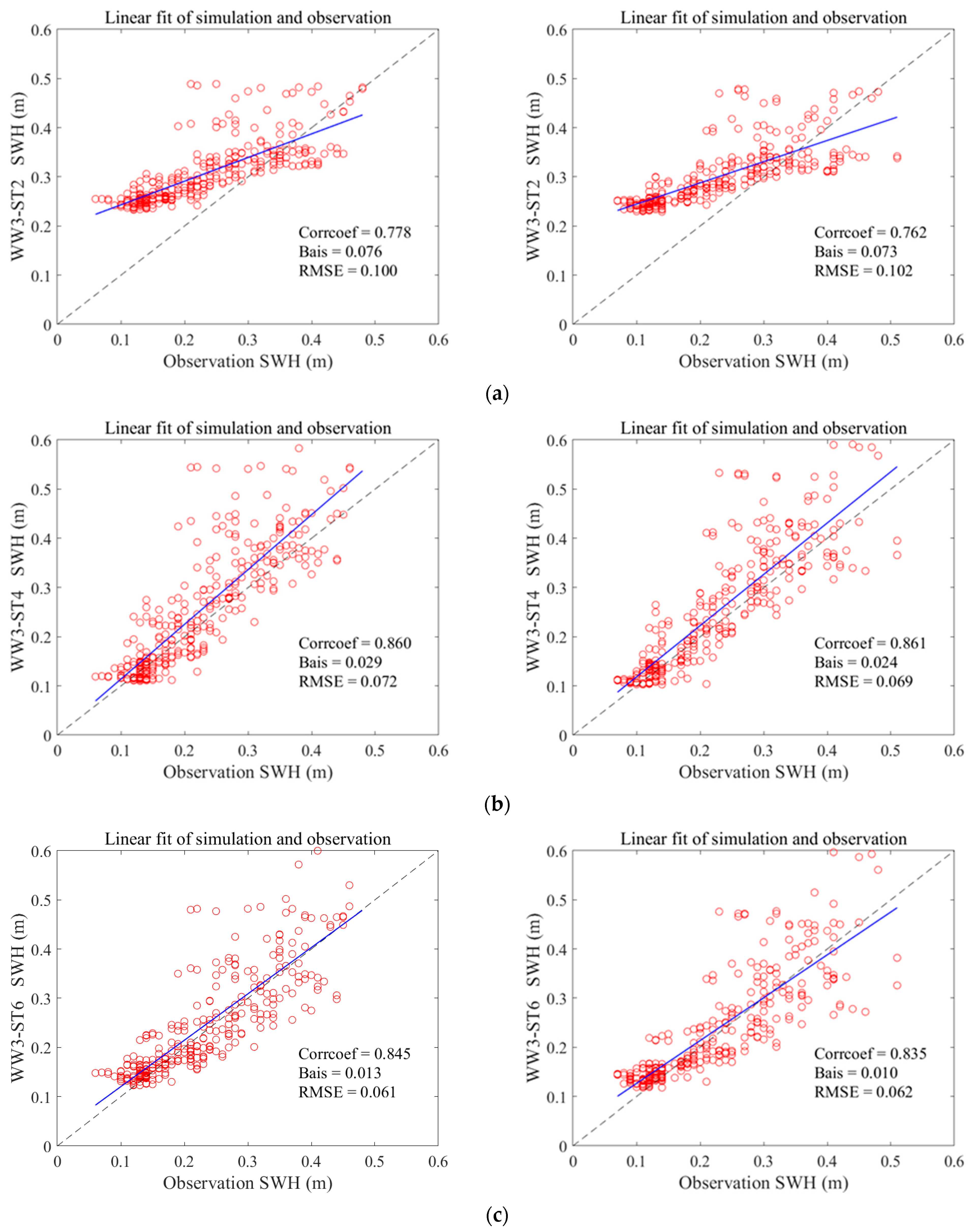

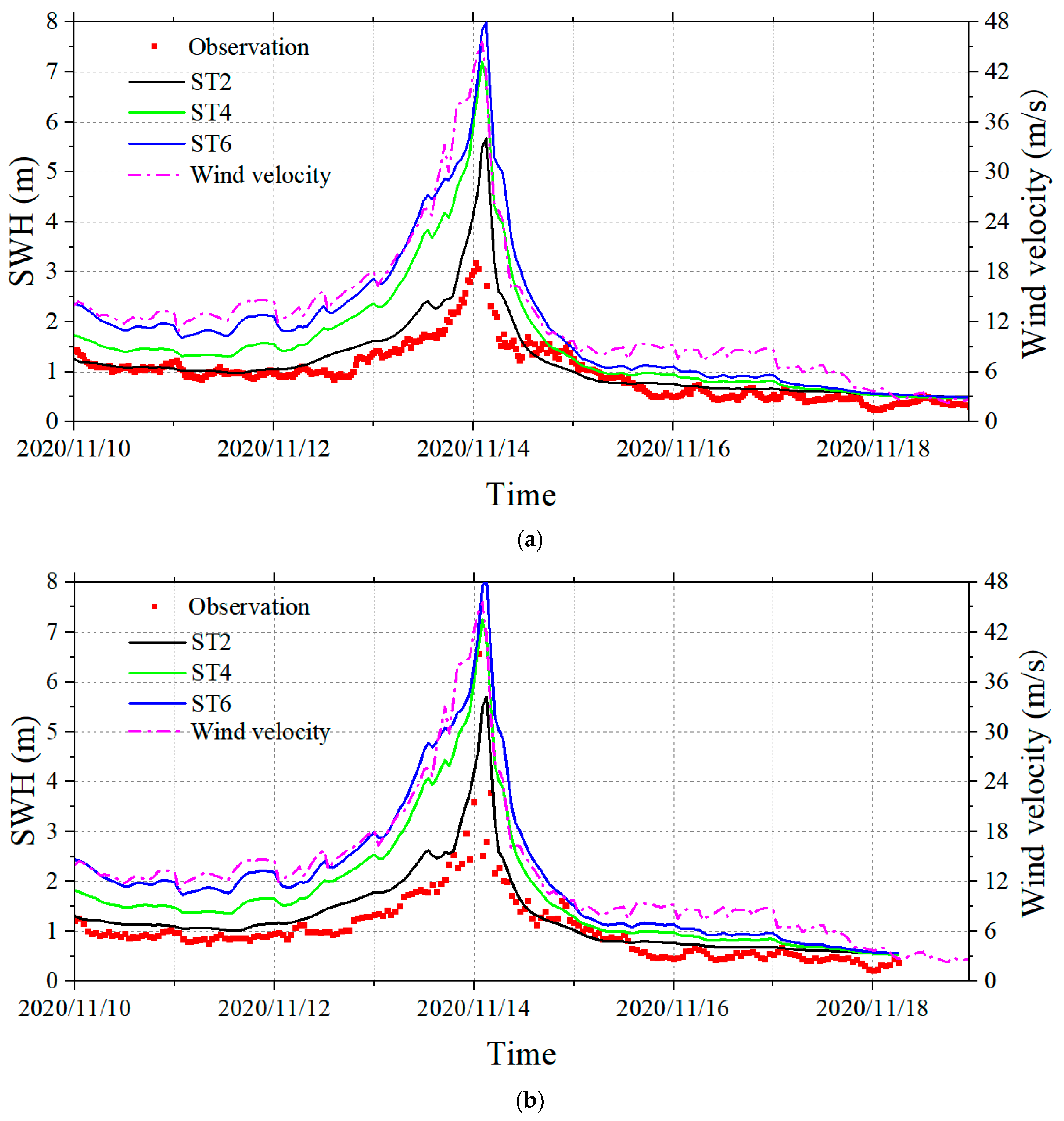

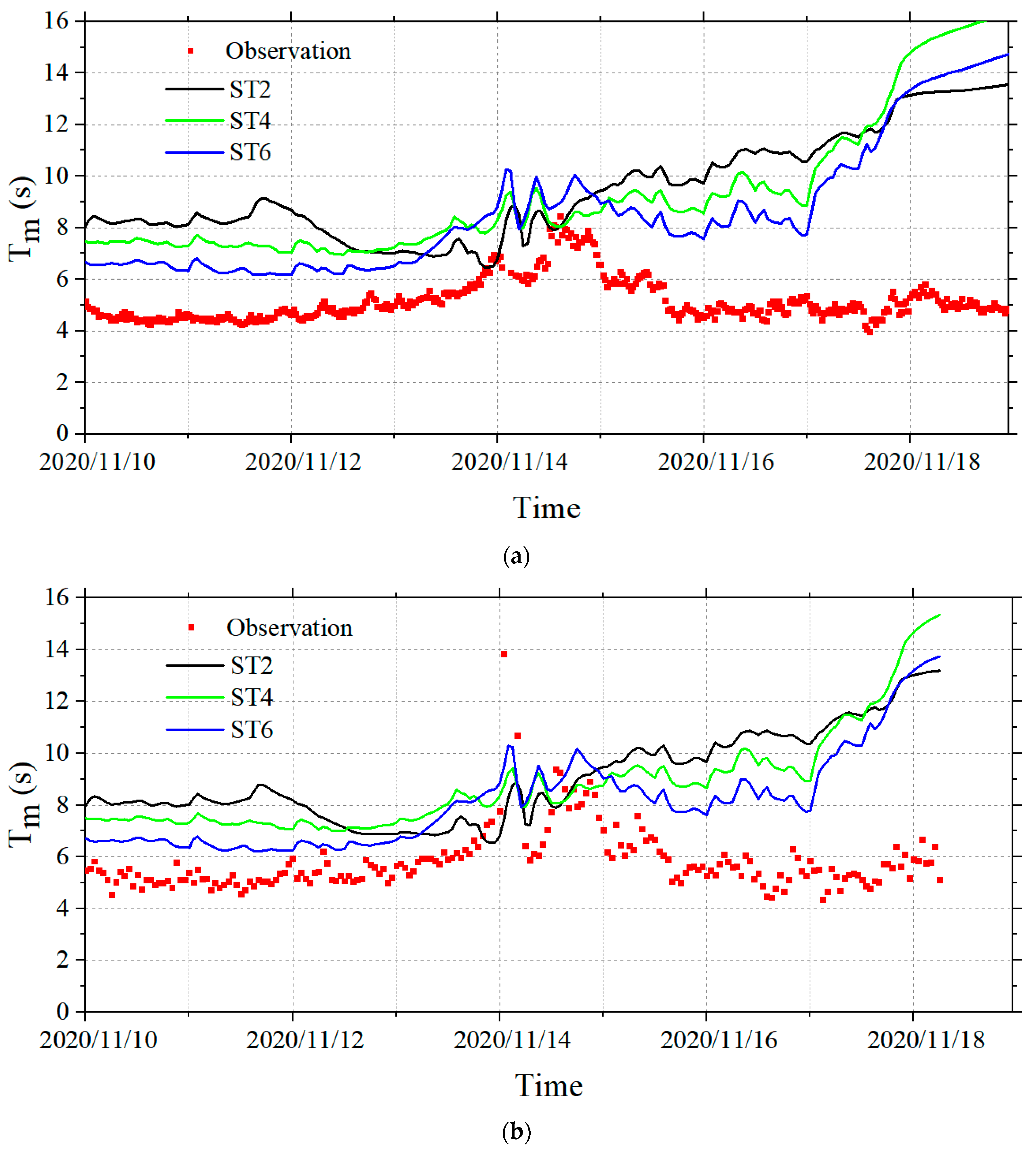
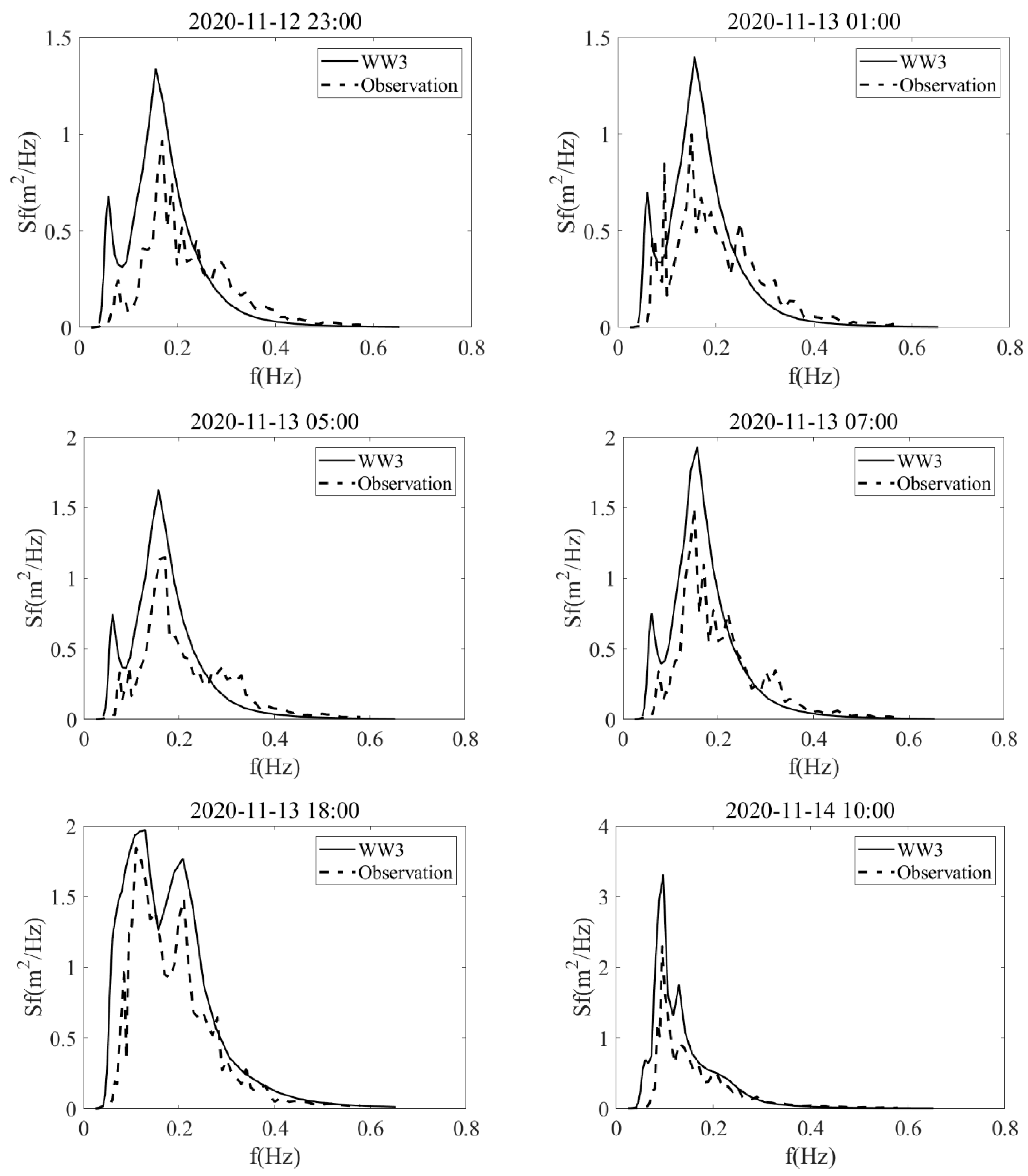

| Source Term | Switch | Description |
|---|---|---|
| Linear input term | LN1 | Cavaleri and Malanotte-Rizzoli 1981 [46] |
| Nonlinear interactions | NL1 | Discrete interaction approximation [47] |
| Wave–bottom interaction | BT1 | JONSWAP bottom friction [36,48,49] |
| Wave breaking | DB1 | Battjes and Janssen 1978 [50] |
| Wind input–dissipation term | ST2/ST4/ST6 | Tolman and Chalikov 1996/Ardhuin et al. 2010/Zieger et al. 2015 [18,19] |
| Source Scheme | Measurement Point | Corrcoef | RMSE | Bias |
|---|---|---|---|---|
| ST2 | Point 1 | 0.778 | 0.076 | 0.010 |
| Point 2 | 0.762 | 0.073 | 0.102 | |
| ST4 | Point 1 | 0.860 | 0.029 | 0.072 |
| Point 2 | 0.861 | 0.024 | 0.069 | |
| ST6 | Point 1 | 0.845 | 0.013 | 0.061 |
| Point 2 | 0.835 | 0.010 | 0.062 |
| Source Scheme | Measurement Point | Corrcoef | RMSE | Bias |
|---|---|---|---|---|
| ST2 | Point 1 | 0.918 | 0.180 | 0.396 |
| Point 2 | 0.894 | 0.244 | 0.455 | |
| ST4 | Point 1 | 0.933 | 0.592 | 0.927 |
| Point 2 | 0.905 | 0.718 | 1.006 | |
| ST6 | Point 1 | 0.936 | 0.909 | 1.276 |
| Point 2 | 0.894 | 1.055 | 1.373 |
Disclaimer/Publisher’s Note: The statements, opinions and data contained in all publications are solely those of the individual author(s) and contributor(s) and not of MDPI and/or the editor(s). MDPI and/or the editor(s) disclaim responsibility for any injury to people or property resulting from any ideas, methods, instructions or products referred to in the content. |
© 2023 by the authors. Licensee MDPI, Basel, Switzerland. This article is an open access article distributed under the terms and conditions of the Creative Commons Attribution (CC BY) license (https://creativecommons.org/licenses/by/4.0/).
Share and Cite
Zou, L.; Liu, L.; Wang, Z.; Chen, Y. Evolution Wave Condition Using WAVEWATCH III for Island Sheltered Area in the South China Sea. J. Mar. Sci. Eng. 2023, 11, 1158. https://doi.org/10.3390/jmse11061158
Zou L, Liu L, Wang Z, Chen Y. Evolution Wave Condition Using WAVEWATCH III for Island Sheltered Area in the South China Sea. Journal of Marine Science and Engineering. 2023; 11(6):1158. https://doi.org/10.3390/jmse11061158
Chicago/Turabian StyleZou, Li, Liangyu Liu, Zhen Wang, and Yini Chen. 2023. "Evolution Wave Condition Using WAVEWATCH III for Island Sheltered Area in the South China Sea" Journal of Marine Science and Engineering 11, no. 6: 1158. https://doi.org/10.3390/jmse11061158
APA StyleZou, L., Liu, L., Wang, Z., & Chen, Y. (2023). Evolution Wave Condition Using WAVEWATCH III for Island Sheltered Area in the South China Sea. Journal of Marine Science and Engineering, 11(6), 1158. https://doi.org/10.3390/jmse11061158




